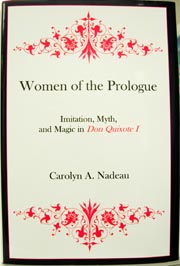Contact: Jeff Hanna, 309/556-3181
Carolyn Nadeau Publishes Volume on Don Quixote
BLOOMINGTON, Ill. -- When students in one of Carolyn Nadeau’s classes at Illinois Wesleyan University see Don Quioxte on the reading list, they may not initially be enthused about the prospect of reading the 17th-century work by Miguel de Cervantes. Once Nadeau begins to show her students the many connections between the world in which they live and the one Cervantes created for his characters, their attitudes change. And when she has them consider the connections between Cervantes’ novel and the music of techno-pop star Moby, she really gets their attention. Cervantes’ story of the hapless knight who mistakes windmills for giants has been central to Nadeau’s own research, and her book, Women of the Prologue: Imitation, Myth, and Magic in Don Quixote I, was published in June by Bucknell University Press. Through her study, Nadeau gained an even greater appreciation for the innovative approach to writing that makes Don Quixote such a valuable subject of continued examination. "When we begin to examine Don Quixote in a class, students can’t imagine what relevance it has to them," says Nadeau. "They quickly begin to see themes that are constantly coming up today." Using Moby’s music, Nadeau draws connections between Cervantes’ ability to control and synthesize past traditions in Don Quixote with the way in which Moby builds upon the past in developing a style that is entirely his own. "These are both examples — Moby’s music and Cervantes’ novel — of how an artist can take past conventions and use them to create something new," Nadeau says. Nadeau’s book focuses on Cervantes’ use of the classical female characters that are cited in a single sentence of Don Quixote’s prologue, which is written in the form of a conversation between the author and an anonymous friend about the way in which the ensuing story should be told. "Cervantes was among the first writers to break from the tradition of having a dialogue with the past and focus instead on a dialogue with his readers," says Nadeau. "But Cervantes could not cut himself off totally from the past. The anonymous friend of the prologue lists six female characters from the past, including Homer’s Calypso and Ovid’s Medea, who could be models for specific types of characters." Though the classical characters mentioned in the prologue never reappear in the text, they serve as models for the strong-minded, independent women in Don Quixote. "Cervantes’ women are very determined to get what they want," Nadeau says. Cervantes, Nadeau says, wanted similar freedoms for writers. As one of the first writers to move consciously away from past literary traditions, the development of the modern novel can be traced to this work. In fact, a recent survey of 100 well-known writers from around the world selected Don Quixote as the most meaningful literary work of all time. Nadeau is delighted to see Cervantes get his credit, but adds that she never puts much stock in such surveys. "There are so many great books out there. They affect readers in many different ways, and it seems almost silly to try to rank one as the best," says Nadeau. A member of the Illinois Wesleyan faculty since 1994, Nadeau received her doctorate from Penn State University. She has a bachelor’s degree from the University of Virginia (1985) and a master’s degree from New York University (1989). She has also written on mythological female figures in the comedia and the role of the wife and mother in sixteenth-century advice manuals. Currently she is researching food representation in Golden Age texts. Earlier this year she was named the 2003 winner of Illinois Wesleyan’s DuPont Award for Teaching Excellence. |
